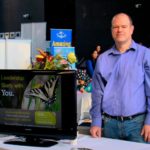 By John Thornburn.
By John Thornburn.
Engagement, inclusion, and relationships. I believe these three simple words are cleverly intertwined in their capacity to maintain change in our communities. Paolo Freire (2007) stated that “the ability to reflect, to program, to investigate, and to transform is unique to human beings in the world and with the world” (p. 34). When I hear the term Bridge for Health, I think of the intertwined relationships amidst mindfulness, spirituality, and wellbeing. I believe these equally simple words co-exist in a unique way to sustain our life energy among others. Although Paolo’s work focused on creating healthy dissonance (and maybe a little bit of a revolution), I think it also provided an opportunity for those who read his work to step back and ask oneself what their impact on the world is. In this sense I think that when he said that “without a vision for tomorrow, hope is impossible” he was trying to entice the reader to maintain the dream of what social impact could be if everyone was engaged (Freire, 2007, p. 45).
The idea of social innovation is not new. Kurt Lewin, the founder of Action Research wrote an interesting article in 1946 titled “Action Research and Minority Problems” in the Journal of Social Issues. In it, he posited that change was a slow process unless driven by crisis which could radically speed up change (Burnes, 2004, p. 230). In our current state we have coined the word social innovation to focus people’s attention to the need to re-engage with our communities. Have we done this because social justice issues have become a crisis?
In the meantime, Bridge for Health is urging us to embrace civic engagement, as an activity that can promote social innovation and health equity. I agree. Mahjabeen, Shrestha, and Dee (2009) believed that “the voices of the traditionally voiceless groups … are critical for plans to succeed in terms of achieving equity, efficiency and sustainability” (p. 46). They further went on to promote their facilitative activities in order to decrease political tokenism and increase civic engagement in Australia. I developed the Building Better Practice model after being influenced by these authors, among others. When I was encouraged by Paola Ardiles to write this blog I felt that our messages were along a similar path. In fact, Bridge for Health is hosting a holiday party that includes a Photovoice Exhibit that engages youth to express their views and perspectives on the social conditions that shape our health.
I am delivering a workshop in Vancouver out of Creekside Community Center on Friday November 21st. There is a cost for the workshop but if you mention Bridge For Health in your email to me I will reduce the cost by 50%. You can register at www.communityinc.tk but first let me describe the model…
The Building Better Practice model is built on a foundation of Participatory Action Research (PAR). PAR as described by Swantz (2008) promotes that “knowledge gained through research needs to become part of people’s lives” (p. 45). To this effect I promote the value of engagement, inclusion, and mindfulness when developing strategies to create civic engagement. The Building Better Practice model promotes the values of Dialogue, Governance, Planning, and Leadership.
When we convene with others, there is value in fostering DIALOGUE. In the workshop I aim to teach the participants how to engage in creative dialogue with all sizes of groups. I teach two specific techniques: Open Space, and Transformative Planning. In each, the participant (you) will learn how to engage others, include their voice, and build momentum in strengthening a community that cares. As part of the second component, I promote our role of Community GOVERNANCE. We are all governors: Governors of our Non-Profit societies, our Faith communities, and our child’s sports groups. As we create a Community Governance Model, I will teach you how to promote social inclusion and leverage individual strengths of those that participate in community group activities. Thirdly, I aim to help participants look at ways to create non-traditional partnerships through a lens of inclusive strategic PLANNING that utilizes networks and outreach practices as the key to building healthy relationships that hope to result in a higher quality of community life and individual social health. Finally, the last leg of the workshop is focused on using performance management techniques to ensure that shared LEADERSHIP is developed in the relationships you are building with your colleagues and those who will soon be your new partners. By sharing simple outcome frameworks and ways to create meaningful terms of reference with your committees, boards, and social groups I strive to put you in the driver seat of social innovation in your community.
As Daniel Pink stated in his novel Drive (2009), the value of intrinsic rewards far outweigh those of extrinsic motivators. I hope that you will join us for this workshop on Friday, November 21st not because I say it will provide you with new insights, but because you know that it will.
Visit the website to register www.communityinc.tk or email me at johnthornburn@shaw.ca
John Thornburn, M.A.
Organizational Leadership Consultant
www.BuildingBetterPractice.com
References
Burnes, B. (2004). Kurt Lewin and the planned approach to change: A reappraisal. In Burke, W., Lake, D. G. & Paine, J. (Eds.). (2009). Organization change: A comprehensive reader. (pp. 226-246). San Francisco, CA: Jossey-Bass.
Freire, P., & Freire, A. M. A (2007). Pedagogy of the heart. New York, NY:The Continuum International Publishing Group.
Lewin, K. (1946). Action Research and Minority Problems. Journal Of Social Issues, 2(4), 34-46. Retrieved from SocINDEX
Mahjabeen, Z., Shrestha, K. K., & Dee, J. A. (2009). Rethinking community participation in urban planning: The role of disadvantaged groups in Sydney Metropolitan strategy. Australasian Journal of Regional Studies, 15 (1), 46-63. Retrieved from http://www.anzrsai.org/download.pl?param=289
Pink, D. H. (2009). Drive: The surprising truth about what motivates us. New York, NY: Riverhood Books.
Swantz, M. L. (2008). Chapter 2: Participatory action research as practice. In Reason, P., & Bradbury, H. (Eds.). The SAGE handbook of action research. (2nd ed.), (pp. 31-48). London, UK: SAGE Publications. doi:10.4135/9781848607934.d8
